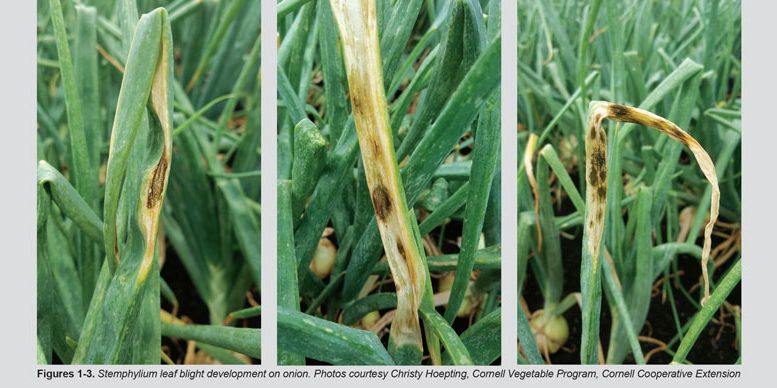By Mary Hausbeck, Ph.D., University Distinguished Professor and Extension Specialist, Michigan State University
Onion leaves don’t seem to get the respect that they deserve. We know the bulbs are what we’re after, but the leaves are the workhorse of this crop because they manufacture the plant food that stokes the bulb size and yield.
These leaves are so important yet susceptible to many pests. When I was a young(er) professor, I expected to find Botrytis leaf blight or purple blotch in my onion field trials and growers’ fields, depending on the time of the season. Sure, downy mildew would develop some years, surprising us with how quickly it wreaks havoc if not caught and managed with the right fungicides.
Then, several years ago, anthracnose developed on onion leaves in fields across Michigan, and we worked to identify the novel pathogen (Colletotrichum coccodes) that had not been reported to previously infect onion leaves. We worked to identify this new pathogen and make fungicide recommendations that have eased the risk posed by this pathogen.
But, it wasn’t too long after that, that another leaf blight appeared in onion fields. My colleague said the onions were “dying with their boots on.” I think that meant that the entire leaf was dying before it was supposed to. At first, all kinds of reasons for the early foliar death were proposed, but it turned out to be a plant pathogen. The culprit was a bacterial pathogen, Pantoea agglomerans, that causes bacterial stalk and leaf necrosis and was a concern for many Michigan producers. With help from my entomology colleague at Michigan State University, Dr. Zsofia Szendrei, we learned that controlling the thrips that move this bacterium around an onion field helps to limit the bacterial disease.
Stemphylium Leaf Blight
We are now onto a new chapter and challenge to keep onion foliage healthy. Stemphylium leaf blight has become a top disease problem for many onion growers in the eastern U.S. For the last several years, Michigan onion growers have struggled to control this disease despite closely following recommended fungicide spray programs. Onion producers that experience frequent rainfall and high humidity expect to encounter various foliar diseases, but Stemphylium leaf blight used to be considered a minor disease in Michigan. However, in recent years, this pathogen has become an aggressive and yearly challenge for onion producers in several eastern U.S. growing regions. Growers are also concerned that severe foliar diseases may contribute to reduced yield and bulb rot in storage.
Stemphylium leaf blight begins as small white oblong lesions that may appear sunken and purple in color with a light-colored border (Fig. 1, Fig. 2). As the blight develops, the lesions run together, resulting in larger blighted areas; eventually, the leaves become brown and necrotic (Fig. 3). Leaf blighting and early death of the leaves reduces bulb yield due to the loss in healthy leaf area.
Our preliminary field results from 2019 indicated that Stemphylium infection may increase bulb disease during storage, likely as a result of secondary pathogens that enter the bulb through the damaged leaves.
Fungicide Trials
Recent field trials show that strobilurin fungicides are not working well in Michigan for Stemphyium leaf blight even though they have been a cornerstone of purple blotch control programs. The strobilurin class of fungicides represents several commonly used active ingredients including azoxystrobin, picoxystrobin, pyraclostrobin and trifloxystrobin. The finding that this important group of fungicides is not able to protect the onion foliage has meant that growers have needed to turn to other fungicides to protect against this destructive leaf blight.
Our research field trials conducted with a grower cooperator showed that applications of Omega SC, Luna Tranquility SC, Miravis Prime SC, Tilt SL and Luna Experience SC protected against Stemphylium leaf blight. Examples of seven-day spray programs that reduced leaf blight in our 2019 field trial and resulted in substantial increase of large bulbs and an increase in total yield compared to the plots that were not treated included:
- Miravis Prime SC alternated with Bravo WeatherStik SC alternated with Tilt SL
- Luna Tranquility SC alternated with Bravo WeatherStik SC alternated with Tilt SL + Koverall DG
There are certainly other effective fungicide programs that can be developed based on disease pressure and weather. We will be testing additional fungicide programs in 2020. An important consideration with the newer fungicides that are effective against Stemphylium is that they must be scheduled carefully as the number of times they can be used per crop/season is limited and may not cover a relatively long cropping cycle, especially when fungicides are sprayed every seven to 10 days. Note that applications of Manzate ProStik DF or Bravo WeatherStik SC alone do not provide enough protection but can be used in a tank mix or in alternation with more effective products.

